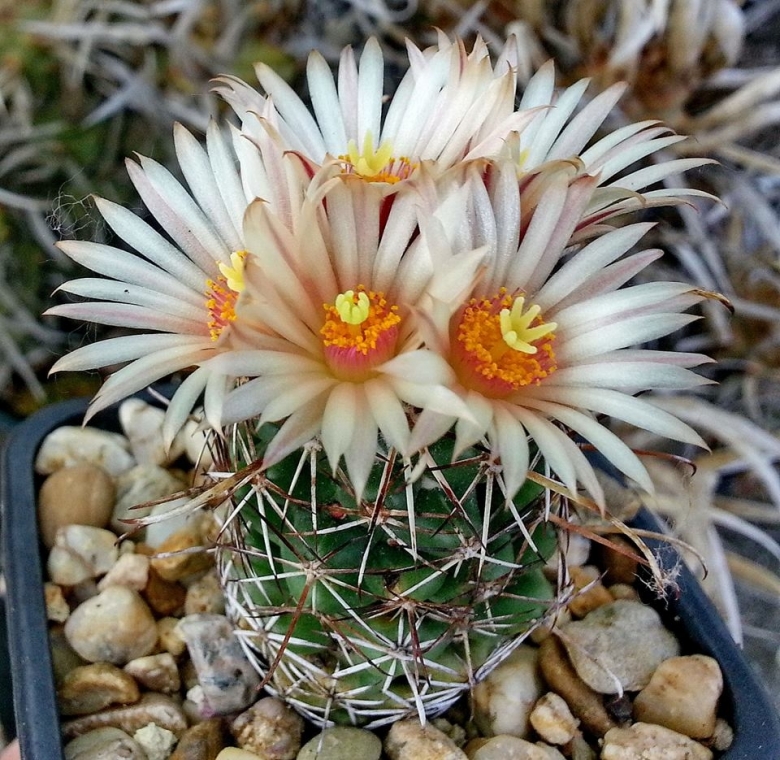= Coryphantha ancistracantha (Lem.) Lem.
Accepted Scientific Name: Coryphantha clavata subs. stipitata (Scheidw.) Dicht & A.Lüthy
Cactaceae Syst. Init. 11: 12. 2001

Coryphantha rhaphidacantha var. ancistracantha (Coryphantha ancistracantha) Photo by: Agócs György
GM 462 (Collector Grzegorz Matuszewski) Locality: Ojo Caliente, 2060m. at: Rebutialand - Cactus collection - Hungary.
Origin and Habitat: Zacatecas, Guanajuato, San Luis Potosi and Jalisco, mainly around Lagos de Moreno
Habitat and ecology: On lower slopes of volcanic hills under bushes, agaves and hechtias.
Synonyms:
See all synonyms of Coryphantha clavata
back
Accepted name in llifle Database:Coryphantha clavata (Scheidw.) Backeb.Cactaceae (Berlin) 1941, Pt. 2, 61 (1942); cf. Gray Herb. Card Cat.Synonymy: 6
Accepted name in llifle Database:Coryphantha clavata subs. stipitata (Scheidw.) Dicht & A.LüthyCactaceae Syst. Init. 11: 12. 2001Synonymy: 16
back
Description: Coryphantha ancistracanthaSN|3896]]SN|3977]] is a solitary cactus species with very large root and long hooked spines. It is generally included within (as a synonym of) Coryphantha clavaSN|3896]]SN|3896]]ta subs. stipitata, suggesting that there is not really a fundamental difference between the two, and hard to name accurately without knowing where they come from.
Coryphantha clavaSN|3896]]SN|3896]]ta subs. stipitata displays 1 (seldom - 4) central spines always with a hooked tip. The flowers are nearly white and slightly larger (30-35 mm diameter) than in ssp. clavata. All the other characteristics are identical to ssp. clavata.
Taxonomic notes: Coryphantha clavaSN|3977]]SN|3896]]ta subs. stipitata was first described by Scheidwwiler (1838) as Mammillaria stipitataSN|3973]]SN|10151]], one year later by Lemaire as Mammillaria raphidacanthaSN|3970]]SN|3970]] and also as Mammillaria ancistracanthaSN|10151]]SN|3973]]. The distribution areas of ssp. clavata and of ssp. stipitata are always disjunct, they occur nowhere together.
Stem: Simple, elongated to club shaped, cylindrical, 10 to 15 cm tall, dark bluish green.
Tubercles: In rows of 5-8, and 13, conical, grooved above, the axils when young bearing short white wool; glands in the groove.one to several, large, red.
Radial spines: 6 to 12, with reddish or black tips.
Central spine: 1 (rarely 4) , somewhat longer than radials, straight or curved (subsp. clavata) or hooked (subsp. stipitata).
Flowers: Small for the genus, about 20-30 m in diameter (subsp. clavata) or 35-40 mm in diameter (subsp. stipitata); outer perianth-segments linear, acute, entire, with broad brownish midrib; inner perianth-segments linear, entire, narrow, creamy white; stamens pinkish, much shorter than the perianth-segments; style pinkish; stigma-lobes 5 or 6, short, greenish.
More...Subspecies, varieties, forms and cultivars of plants belonging to the Coryphantha clavata group
 Coryphantha ancistracantha (Lem.) Lem.: Same as: Coryphantha clavata subs. stipitata
Coryphantha ancistracantha (Lem.) Lem.: Same as: Coryphantha clavata subs. stipitata Coryphantha clavata (Scheidw.) Backeb.: (subsp. clavata) Central spine straight or curved. Flowers 20-30 m in diameter. Distribution: Aguascalientes, Guanajuato, Hidalgo, Jalisco, Querétaro, San Luis Potosí and Zacatecas.
Coryphantha clavata (Scheidw.) Backeb.: (subsp. clavata) Central spine straight or curved. Flowers 20-30 m in diameter. Distribution: Aguascalientes, Guanajuato, Hidalgo, Jalisco, Querétaro, San Luis Potosí and Zacatecas. - Coryphantha clavata subs. stipitata (Scheidw.) Dicht & A.Lüthy: Central spine always hooked. Flowers 35-40 m in diameter. Distribution: Zacatecas, Guanajuato, San Luis Potosi and Jalisco, mainly around Lagos de Moreno.
Bibliography: Major references and further lectures
1) Reto Dicht, Adrian Lüthy “Coryphantha: Cacti of Mexico and Southern USA” Springer Science & Business Media, 14 mar 2006
2) Nathaniel Lord Britton, Joseph Nelson Rose “Cactaceae: Descriptions and Illustrations of Plants of the Cactus Family” vol. 4 The Carnegie Institution of Washington, Washington 1923











